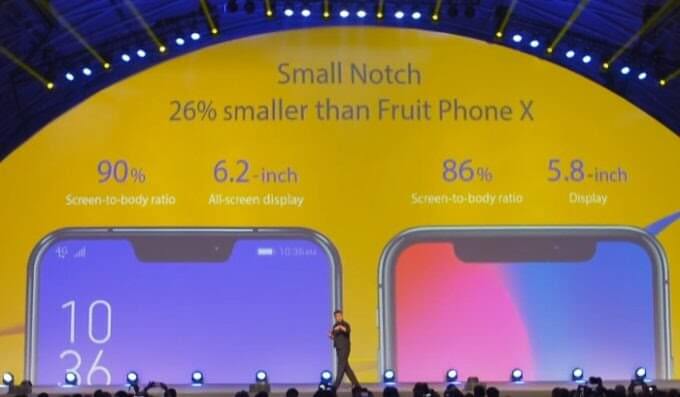On Tuesday, Asus launched its ZenFone 5 Series of smartphones at MWC 2018 in Barcelona, Spain. The company launched the ZenFone 5Z, ZenFone 5, and ZenFone 5 Q/Lite. All the smartphones offers a AI-enabled feature, “all-screen” 18:9 displays that deliver a 90 percent screen-to-body ratio, and dual camera setups. Also new is ZeniMoji, Asus’s own take at Apple’s Animoji. All three smartphones are powered by Qualcomm SoCs. The company also unveiled the ZenFone Max (M1), a smaller variant of the ZenFone Max Plus (M1), powered by the Qualcomm Snapdragon 430 or Snapdragon 425 SoC.
“We embarked on the ZenFone project four years ago with the idea to create empowering luxury for everyone to enjoy,” said Asus CEO Jerry Shen. “Today, the ZenFone 5 Series is the most intelligent ZenFone series ever, utilizing advanced AI algorithms and big-data analytics to provide users with a unique slate of intelligent camera, communication and convenience features,” Shen added
ASUS ZenFone 5Z

| Specs | ASUS ZenFone 5Z |
|---|---|
| Display | 6.2-inch Full HD+ (2246 x 1080) LCD |
| Processor | Qualcomm Snapdragon 845 |
| RAM | 6GB |
| Storage | 64GB |
| Rear Camera | Dual cameras: 12MP wide-angle lens with f/1.8 aperture + 12MP sensor with f/1.8 aperture |
| Front Camera | 8MP with f/2.0 aperture |
| Battery | 3,300mAh |
| Connectivity | 802.11 a/b/g/n/ac, BT 5.0, GPS, NFC |
| Software | Android Oreo with ZenUI 5.0 |
The ASUS ZenFone 5Z is the flagship of ASUS’s 2018 ZenFone lineup, features a 90 percent screen-to-body ratio, “premium materials” and a small, compact glass-covered body that measures 5.5 inches. Its features include Qualcomm’s Snapdragon 845, 6GB of RAM, 64GB of UFS 2.1 storage, a dual camera setup, and 2.5D 6.2-inch Full HD+ (2246 x 1080) screen.
 The above-mentioned screen, which has an FRUIT/APPLE iPHONE X (as Asus said) like notch on the left side to accommodate the front-facing camera, supports DCI-P3 color space and wide color gamuts. It also taps ASUS’s intelligent display technology to adjust the color temperature automatically in response to ambient light changes. Screen On, another handy feature from the brand prevents the phone’s display from turning off when you’re glancing at it.
The above-mentioned screen, which has an FRUIT/APPLE iPHONE X (as Asus said) like notch on the left side to accommodate the front-facing camera, supports DCI-P3 color space and wide color gamuts. It also taps ASUS’s intelligent display technology to adjust the color temperature automatically in response to ambient light changes. Screen On, another handy feature from the brand prevents the phone’s display from turning off when you’re glancing at it.
The ASUS ZenFone 5 Z’s vibrant screen is supported by three noise-canceling microphones and two five-magnet speakers in stereo configuration, driven by dual amplifiers. The smartphone features Hi-Res Audio and files encoded up to 24-bit, and DTS’s Headphone-X technology for 7.1-channel virtual surround sound on supported headphones.
The smartphone not only packs a powerful screen and stereo speakers but it also has a dual rear camera setup with Sony’s IMX 363 sensor and a six-element lens, and a 8MP front camera with a f/2.0 aperture. The 12MP snappers which have a f/1.8 aperture and 1.4um pixel size, tap dual-pixel phase detection autofocus (PDAF) and takes just 0.03 seconds to focus, and a four-axis optical image stabilization system that reduces blur.
One of the sensors has a 120-degree wide-angle lens, and both take advantage of a “night HDR” mode that delivers up to 5 times brighter and clearer photos. Coming to the video, the ASUS ZenFone 5Z can capture smooth 4K UHD clips at 60FPS stabilized with the help of three-axis Electronic Image Stabilization (EIS).
Qualcomm’s Snapdragon 845 is essentially the heart of the ASUS ZenFone 5Z. The chipset comprises Qualcomm’s latest Kryo 385 core design, and packs the new Adreno 630 GPU, optimized-for-AI Hexagon DSP, and Spectra 280 ISP.
The 5Z comes with a variety of new AI-powered features in ASUS’s new ZenUI 5.0. It has an energy-saving service called AI Charging which automatically adjusts the phone’s charging rate in response to your usage habits (ASUS claims it “slows down the battery aging process”), and AI Ringtone changes the smartphone’s call volume in response to ambient noise.
 When it comes to photos, AI Scene Detection uses algorithms to analyze subjects in real time and match them to one of 16 scene types, optimizing for different lighting conditions. Real-time Portrait Mode gives you a bokeh effect by blurring the background of photos while keeping the foreground intact. And Real-Time Beautification brightens your skin tone, clears stress lines, and applies other digital enhancements based on 365 facial points. It works in real time, and surprisingly in live-streaming video apps too.
When it comes to photos, AI Scene Detection uses algorithms to analyze subjects in real time and match them to one of 16 scene types, optimizing for different lighting conditions. Real-time Portrait Mode gives you a bokeh effect by blurring the background of photos while keeping the foreground intact. And Real-Time Beautification brightens your skin tone, clears stress lines, and applies other digital enhancements based on 365 facial points. It works in real time, and surprisingly in live-streaming video apps too.
Other ZenFone 5Z highlights include a 3,300mAh battery, super-fast biometric security- the device’s facial authentication can unlock it in 0.1 seconds, and its fingerprint sensor can unlock it in 0.3 seconds.
Connectivity options on the device include, 802.11a/b/g/n/ac Wi-Fi, Bluetooth 5.0, NFC, a FM radio, a dual SIM slot, and a USB Type-C port. It cost you $499 ( approx. INR 32480), and ships with Android Oreo.
ASUS ZenFone 5
| Specs | ASUS ZenFone 5 |
|---|---|
| Display | 6.2-inch QHD (2246 x 1080) LCD |
| Processor | Qualcomm Snapdragon 636 |
| RAM | 4GB/6GB |
| Storage | 64GB |
| Rear Camera | Dual cameras: 12MP wide-angle lens with f/1.8 aperture + 12MP sensor with f/1.8 aperture |
| Front Camera | 8MP with f/2.0 aperture |
| Battery | 3,300mAh |
| Connectivity | 802.11 a/b/g/n/ac, BT 5.0, GPS, NFC |
| Software | Android Oreo with ZenUI 5.0 |
The ASUS ZenFone 5 is nearly identical to the 5Z. It has got the same premium materials, a compact body, 2.5D 6.2-inch Full HD+ (2246 x 1080) LCD display, stereo speakers, and Android Oreo with ZenUI 5.0 skin. But it’s not a complete carbon copy.
One of the primary difference between the ZenFone 5 and the 5Z is the processor. While the 5Z has Qualcomm’s Snapdragon 845, the ZenFone 5 has Qualcomm’s Snapdragon 636 paired with an Adreno 509 GPU. ASUS says that Snapdragon 636 ( first seen on Xiaomi Redmi Note 5 Pro) delivers 40 percent faster CPU performance and 10 percent better graphics than the Snapdragon 630.
The ZenFone 5 also has slightly less capable snappers than the 5Z — its dual rear cameras lack phase detection autofocus (PDAF) and four-axis OIS (Optical Image Stabilization). However, like the ASUS ZenFone 5Z, they’re capable of shooting in up to 4K at 60FPS, and both the front and rear cameras are three-axis stabilized with EIS (Electrical Image Stabilization).
ASUS didn’t announce pricing for the Zenfone 5, but said it’ll come in RAM configurations— one with 4GB of RAM and one with 6GB of RAM (both with 64GB of storage and microSD slots). It will be available in two colors: Midnight Blue and Meteor Silver.
ASUS ZenFone 5Q/Lite

| Specs | ASUS ZenFone 5Q |
|---|---|
| Display | 6-inch QHD (2160 x 1080) 18:9 LCD |
| Processor | Qualcomm Snapdragon 630 |
| RAM | 4GB |
| Storage | 64GB |
| Rear Camera | Dual rear cameras: 20MP sensor with f/2.0 aperture + 20MP sensor with f/2.6 aperture |
| Front Camera | Dual front cameras: 16MP with f/2.0 aperture + 16MP with f/2.0 aperture |
| Battery | 3,300mAh |
| Connectivity | 802.11 a/b/g/n/ac, BT 4.1, GPS, NFC |
| Software | Android Oreo ZenUI 5.0 |
The ZenFone 5Q or ZenFone 5 Lite, depending on the market/region is slightly lighter (in terms of specs) from the 5 and 5Z. It boasts a 4-camera setup with a 20MP rear and a 16MP front sensor. It has dual internal microphones with noise-canceling tech, an FM radio, a 120-degree wide-angle lens, and a 6-inch Full HD+ (2160 x 1080) 18:9 display.
The dual rear and front cameras are 20MP with f/2.0 aperture and 16MP with f/2.2 aperture and one sensor in each pair has a 120-degree wide-angle lens. Unique feature? ASUS says all four camera sensors can be controlled independently of one another. Using the pre-loaded camera effects doesn’t require using the secondary sensor in conjunction with the primary camera. Moreover, the rear cameras can record in up to 4K resolution with three-axis EIS.
The processor on the device is Qualcomm’s Snapdragon 630, paired with an Adreno 508. ASUS says that its power efficiency combined with the 5Q’s 3,300mAh battery which delivers up to 24 days of 4G standby time and 4 days of music playback.
The device has 4G RAM and 64GB internal storage model (expandable with a microSD card). And will be available later this year in Midnight Black, Moonlight White, and Rouge Red. Like the ASUS ZenFone 5Z and ZenFone 5Q, will also ship with Android Oreo and ZenUI 5.0.
Asus ZenFone Max (M1) (ZB555KL)

| Asus ZenFone Max (M1) (ZB555KL) Hardware Specs | |
|---|---|
| Display | 5.5-inches HD+ (1440 x 720 pixels), IPS LCD |
| Processor | Qualcomm Snapdragon 425 / 430 |
| RAM | 2GB / 3GB |
| Storage | 32 GB |
| Primary Camera | Dual: 13 MP (f/2.0) + 8 MP (17mm, no AF) |
| Secondary Camera | 8 MP (f/2.2, 25mm) |
| Battery | Li-Ion 4,000mAh |
| Operating System | Android 7.1 Nougat |
| Colors | Deepsea Black, Sunlight Gold, Ruby Red |
| Price | TBA |
The Asus ZenFone Max M1 sports a 5.5-inch HD+ (720×1440 pixels) IPS display with an 18:9 aspect ratio, and is offered in two variants – one powered by the Snapdragon 425 and another, by the Snapdragon 430. Both versions will have 3GB RAM and 32GB of internal storage that will be expandable by a microSD card of up to 256GB. The device will have a fingerprint sensor on the back, and has a 4,000mAh battery.




























